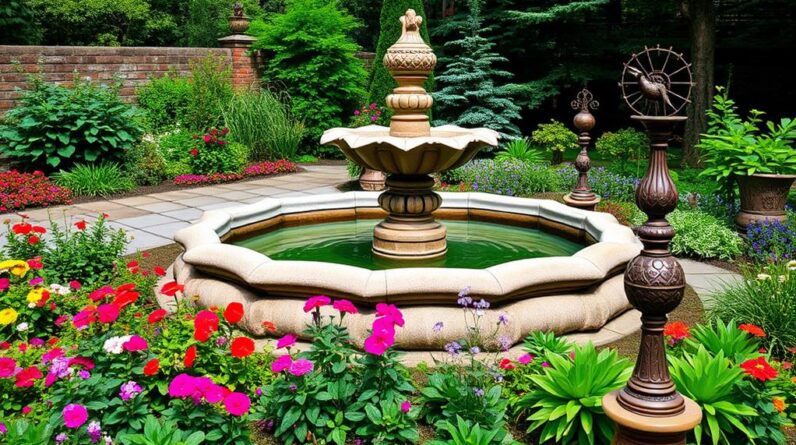
Are you tired of boring, traditional landscapes that serve no purpose? Get ready to revolutionize your outdoor space with edible landscaping!
By integrating edible plants into your landscape design, you can create a stunning and innovative environment that not only looks beautiful but also provides you with a bountiful harvest.
Imagine stepping outside and plucking fresh fruits and vegetables straight from your garden.
It's time to unleash your creativity and transform your landscape into a food paradise!
Key Takeaways
- Edible landscaping adds beauty and functionality to outdoor spaces.
- It promotes biodiversity, supports the ecosystem, and reduces carbon footprint.
- Designing an edible landscape involves incorporating a variety of edible plants, dividing the landscape into zones, and utilizing vertical gardening techniques.
- Selecting the right edible plants requires considering climate and soil conditions, choosing plants suited for the region, and integrating a diverse range of plants for a bountiful landscape.
Benefits of Edible Landscaping
You'll love the many benefits of edible landscaping. Incorporating edible plants into your landscape design not only adds beauty but also provides a sustainable and functional space.
By growing your own fruits, vegetables, and herbs, you have access to fresh and healthy produce right outside your doorstep. Imagine plucking a ripe tomato or harvesting fragrant herbs for your meals.
Edible landscaping also promotes biodiversity by attracting beneficial insects, birds, and butterflies to your garden. It creates a habitat for pollinators, helping to support the ecosystem.
Moreover, growing your own food reduces your carbon footprint by eliminating the need for transportation and packaging. It empowers you to take control of your food source, leading to a healthier lifestyle and a deeper connection to nature.
Embrace the innovative concept of edible landscaping and reap the many rewards it offers.
Designing Your Edible Landscape
When designing your edible landscape, consider the layout and arrangement of your plants to maximize both aesthetic appeal and functionality. Here are three key factors to keep in mind:
- Diversity: Incorporate a variety of edible plants to create visual interest and ensure a continuous harvest throughout the year. Mix different colors, textures, and sizes to create a dynamic and visually appealing landscape.
- Zoning: Divide your edible landscape into different zones based on the needs of the plants. Group together plants with similar sun, water, and soil requirements. This will make maintenance easier and ensure that each plant thrives in its designated area.
- Vertical gardening: Make the most of your space by incorporating vertical gardening techniques. Use trellises, arbors, and vertical planters to grow climbing plants like tomatoes, cucumbers, and beans. This not only saves space but also adds a vertical element to your landscape design.
Selecting the Right Edible Plants for Your Landscape
To create a successful edible landscape, it's important to carefully choose and integrate a variety of edible plants into your design. Selecting the right plants for your landscape is crucial as it determines not only the aesthetic appeal but also the productivity of your edible garden.
Consider the climate and soil conditions of your area to ensure that the plants you choose will thrive. Look for plants that are well-suited for your region and have a high yield. Additionally, opt for plants that have a long growing season or those that can be harvested multiple times throughout the year.
By carefully selecting a diverse range of edible plants, you can create a beautiful and bountiful landscape that provides fresh produce for your enjoyment.
Now, let's explore how to maintain and care for your edible landscape.
Maintaining and Caring for Your Edible Landscape
Take a few minutes each day to inspect your edible landscape for any signs of pests or diseases. Regular monitoring is essential to maintaining the health and productivity of your plants.
Here are three important steps to help you care for your edible landscape:
- Implement Integrated Pest Management (IPM) techniques: IPM focuses on using a combination of biological, cultural, and chemical controls to manage pests effectively. This innovative approach reduces the reliance on synthetic pesticides and encourages natural pest management methods.
- Provide proper irrigation: Ensure your edible plants receive adequate water without overwatering. Use drip irrigation or soaker hoses to deliver water directly to the roots and avoid wetting the foliage, which can lead to disease.
- Mulch and weed regularly: Apply a layer of organic mulch around your plants to suppress weeds and conserve moisture. Pull out any weeds that appear, as they compete with your edible plants for nutrients and water.
By following these maintenance practices, you can ensure the longevity and productivity of your edible landscape.
Now, let's move on to the next section and explore the joy of harvesting and enjoying the fruits of your labor.
Harvesting and Enjoying the Fruits of Your Edible Landscape
Pick a handful of ripe berries from your edible landscape to savor the delicious flavors straight from your garden. Harvesting and enjoying the fruits of your edible landscape is one of the most rewarding experiences in gardening. Not only do you get to enjoy the beauty of your landscape, but you also get to indulge in the flavorful and nutritious produce it yields. To help you make the most of your harvest, here is a table showcasing some popular edible plants and their ideal harvesting time:
| Plant | Ideal Harvest Time | Tips for Harvesting |
|---|---|---|
| Strawberries | Spring to summer | Gently twist the berry off the stem to avoid damaging plants |
| Tomatoes | Summer | Harvest when the fruit is firm and fully colored |
| Blueberries | Summer | Give a gentle tug; ripe berries should easily detach |
| Apples | Fall | Twist the apple gently; it should come off easily |
Remember to harvest your fruits during their peak ripeness for the best flavor and nutrition. Enjoy the bountiful rewards of your edible landscape!
Frequently Asked Questions
Can Edible Landscaping Help Reduce Food Waste?
Yes, edible landscaping can help reduce food waste. By integrating edible plants into your landscape design, you can grow your own food, reducing the need for store-bought produce and minimizing food waste in the process.
How Can I Ensure That My Edible Landscape Is Environmentally Sustainable?
To ensure an environmentally sustainable edible landscape, focus on four factors: proper plant selection, soil health, water conservation, and organic pest control. By implementing these practices, you'll create a thriving, eco-friendly garden.
Are There Any Specific Edible Plants That Are Safe for Pets?
Yes, there are specific edible plants that are safe for pets. Some examples include carrots, cucumbers, and blueberries. These plants can be a tasty and healthy addition to your edible landscape while keeping your furry friends safe.
Can Edible Landscaping Actually Save Me Money on Groceries?
Yes, edible landscaping can save you money on groceries. By growing your own fruits, vegetables, and herbs, you can reduce your trips to the grocery store and enjoy fresh, organic produce right from your backyard.
Is It Possible to Integrate Edible Plants Into a Small Urban Garden or Balcony Space?
Yes, it is absolutely possible to integrate edible plants into a small urban garden or balcony space. By utilizing vertical gardening techniques and selecting compact varieties, you can create a thriving edible oasis right at your fingertips.












